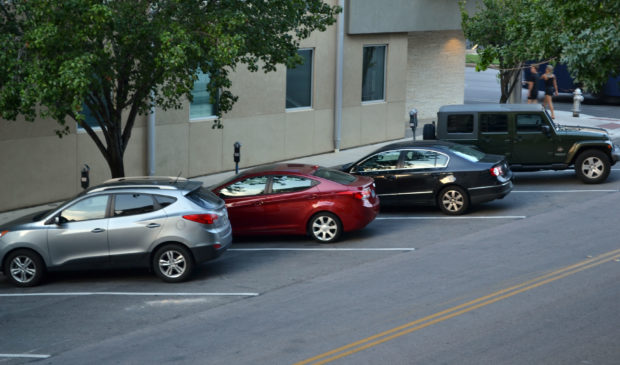A census, but for downtown parking
Wednesday, May 11, 2016 by
Caleb Pritchard In a city obsessed with mobility issues, even parking can be a flashpoint that excites visceral debates about whether there is too much or not enough temporary vehicular storage. Soon, however, the Downtown Austin Alliance will temper parking passions with cold hard data mined from a sweeping census of all available spaces in the city’s bustling core.
Dubbed the “Downtown Austin Parking Strategy,” the DAA is selling it as a new take on a routine parking inventory.
“The studies that have been done in the past have primarily been focused on the public sector parking. So street parking, structured parking, the parking which is controlled by the city,” DAA President and CEO Dewitt Peart said at a press conference in downtown Austin on Tuesday morning. “We’re bringing the private sector into the fold.”
Peart added that the DAA has tapped San Francisco-based Nelson\Nygaard Consulting Associates to conduct the approximately $260,000 study. The scope of the analysis will cover the larger downtown area from Judges Hill in the northwest to Rainey Street in the southeast, and from the Pfluger Pedestrian Bridge in the southwest to the Frank Erwin Center in the northeast. It also skips across Lady Bird Lake to include the South Central Waterfront.
And it won’t be simply limited to an inventory of currently available parking, Peart said.
“Parking is an element, but this also takes into consideration all of the other mobility factors that surround parking. So what we can anticipate are recommendations tying parking with the other mobility options that exist or will potentially exist in the future,” said Peart.
He speculated that potential recommendations could include constructing more parking on the periphery of downtown, or even bringing back a downtown circulator line à la the defunct ‘Dillo service, which Capital Metro sacrificed to help budget for MetroRail.
The DAA last conducted a downtown parking analysis in 2009 with Walker Parking Consultants.
That study looked at an area with substantial differences from the one currently under the microscope. For example, it left out most of northeast downtown, where state-owned garages stretch for blocks along Trinity and San Jacinto streets. Like the current study, the 2009 version also jumped south across the lake but included the Long Center and the Hyatt Regency.
The final report from that study found that there were 48,912 spaces in the examined area — which did not include private facilities that were inaccessible — and that 30,103 of them were occupied during weekday business hours. The report considered that ratio to be “adequate to meet parking demand during most occasions,” but conceded that some downtown drivers perceived a parking shortage primarily because “some of the available supply of parking spaces are not conveniently located and are not immediately visible to the infrequent parker.”
On Tuesday, Peart suggested that tools such as digital signs giving updated directions to available parking spaces in real-time could be one solution. “Tying (in) technology to help take some of the questions out of commuters’ minds or visitors’ minds, I think that’s all part of this,” he said.
Of course, downtown Austin has seen rapid change since the 2009 study. It is now home to 12,000 residents, and more than 82,000 workers each day fill its offices, shops, restaurants and bars. An impressive array of new towers has reshaped the skyline, many of them sitting atop large parking plinths that have substantially added to the area’s inventory.
Those parking structures were built — and are continuing to be built — despite the fact that there are no requirements for off-street parking in much of downtown, indicating that developers are confident that people will continue to drive into, around and out of downtown for decades to come.
After Tuesday’s press conference, Peart told the Austin Monitor that the new parking strategy will assess the impact of that added parking capacity and also attempt to anticipate future supply and demand. He said that this included looking at the potential impact of autonomous vehicles, which some have speculated could greatly reduce the need for parking if they are ever successfully deployed.
“I don’t know that that happens in 10 years, but it’s in the future somewhere,” Peart guessed.
The Downtown Parking Strategy will be guided by a steering committee made up of nine members representing the city, state, Capital Metro and private interests. It formally kicks off with public input sessions, beginning with a community workshop at 5:30 p.m. on Wednesday at the Google Fiber Space, 201 Colorado St.
You're a community leader
And we’re honored you look to us for serious, in-depth news. You know a strong community needs local and dedicated watchdog reporting. We’re here for you and that won’t change. Now will you take the powerful next step and support our nonprofit news organization?









